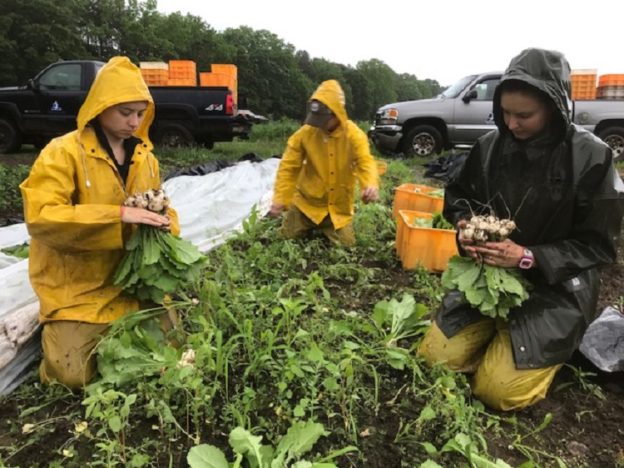We don’t mind harvesting in the rain, especially at this time of year when we’re working with crops that prefer cool weather. There’s less stress on us because we’re not worried about the sun wilting the greens. And we can save time by loading crates of veggies directly onto the trucks. During a sunny harvest, we stack crates in patches of shade cast by the trucks, and then load them when we’re ready to move. When it’s not efficient to head directly in to the wash station, we may load, move, and then unload back into the shade of the truck as we arrive at a new harvest area. None of that to worry about this morning, but we still had to get our work done quickly so as to get to the restaurants on time. That may account for our serious faces (pictured below) as we bunched up Japanese white salad turnips.

If you haven’t had Japanese white salad turnips before, set your turnip preconceptions aside. These are sweet and can be eaten raw or lightly cooked. I like to halve them, start them sauteing in olive oil, add scallions, then add the turnip greens—total cooking time is about five minutes. I dress it while it’s cooking: shoyu, rice and ume plum vinegar, Sir Kensington’s mustard, lemon, and maybe a little maple syrup. Freshly harvested turnips, scallions, lettuce and greens are available at the farm stand by admissions right now!
In advance of this heavy rain, we focused on weed control. The soil was dry and the sun was shining, so we’ve been hoeing, running the flex tine over established crops, and using the Star hoe to hill up potatoes and fertilize tomatoes, summer squash, and cucumbers. On Wednesday, we hosted a meeting on weed control for area farmers, and demonstrated various implements and hoes. The end goal of our approach is to minimize hand-weeding, which is most costly in terms of time. But there will always be weeds to pull, especially under the row covers that have been protecting onions and brassicas since early May. Now that those crops have grown to a size where they can withstand pest pressure, we began removing the covers last week.
On Tuesday, volunteers from Dell helped us haul in 3 sections of row cover and transport about 400 sand bags back to Rock Island. That was the first time volunteers assisted with that, and they did a great job! They also planted scallions and cucumbers and hand-weeded onions (pictured below).

On Friday, volunteers from Goldman Sachs returned for the second year in a row, again making a donation to help us purchase herbs. They planted rosemary and dahlias, and then really seemed to enjoy weeding in the perennial garden (pictured below). So helpful for us since the weeds are endless there.

On Saturday, drop-in volunteers wowed us once again by planting over 3,000 leeks (pictured below) and then rescuing some spring onions from a scary patch of weeds. All the volunteer help we received this week illustrates one definition of sustainable farming at Drumlin: we provide the opportunity for others to learn about what we do and to help us, and their generosity sustains the farm.

Meanwhile, strawberries. They’re coming! But slowly. Strawberries have been a crop that have been affected by the rainy spring we’ve had. We’ve moved our annual Strawberry Day ahead one Saturday to the 22nd so they have more time in the sun before harvesting.
Snap peas are also starting–and are so sweet! If you close your eyes while eating one this image might arise: green chocolate milk!
See you in the field,
Your Farmers


